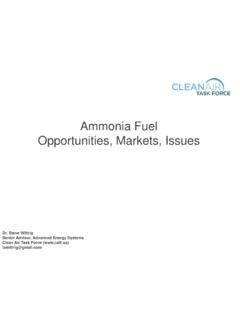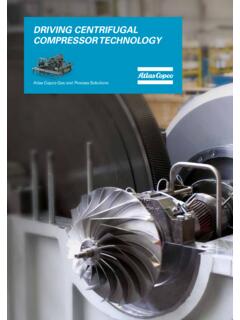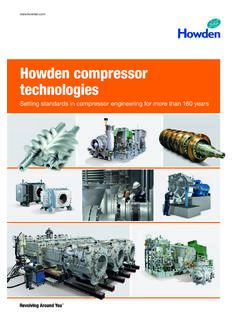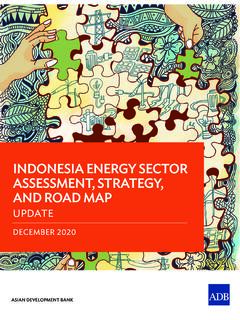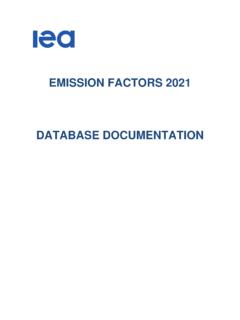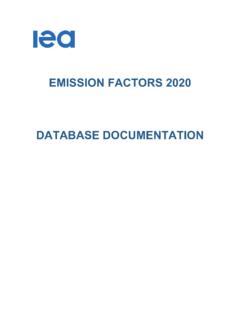Transcription of AMMONIA – THE OTHER HYDROGEN - Productivity Commission
1 AMMONIA THE OTHER HYDROGEN . Rebecca Dunn, Keith Lovegrove Solar Thermal Group Department of Engineering Australian National University ABSTRACT. This paper reviews many aspects of the use of AMMONIA as a renewable fuel, including the properties of the fuel itself, and current developments in the field. Most notable among the properties of AMMONIA is the high energy density. Current developments in the field of AMMONIA fuel use include advances in solid state AMMONIA synthesis, direct AMMONIA fuel-cells, combustion characterisation of AMMONIA -powered Internal Combustion engines and on-vehicle storage innovations with metal ammines. In addition, commercial projects are currently underway in the US to utilise hydroelectric power from Niagara Falls and wind power in the mid-west to produce AMMONIA . The ANU Solar Thermal Group is in the process of commercialising a baseload electricity generation process involving an AMMONIA -dissociation-based storage system.
2 The synergies possible between this process and AMMONIA production lead to a comparison between the use of concentrating solar thermal energy to produce AMMONIA as an alternative to using this same energy to generate baseload electricity via the aforementioned process. The solar-to-end-product efficiency was found to be 15% for the production of AMMONIA fuel, and 26% for the generation of baseload electricity. INTRODUCTION. A future energy economy based on HYDROGEN that is derived from splitting water using renewable energy is a much discussed element of a truly ecologically sustainable society. A range of technology solutions have been presented that address the various technical challenges. Implementing technical solutions in an economically feasible manner is possibly the greatest challenge. If electrolysis of water using renewable electricity is chosen as the method of production, then extra capital cost and energy losses must be added to the already challenging task of producing renewable electricity at least cost.
3 The next challenge is the storage and transport of an element that is naturally gaseous and has an extremely low temperature for liquification. High pressure vessels, cryogenic tanks and metal hydride banks are all technically possible options, once again at a cost. Each of these would also require a major global shift in the nature of energy infrastructure. An alternative approach to the storage and transport issue is to combine HYDROGEN into a compound that preserves the energy value but is easier to transport as a liquid. Methanol is one option, AMMONIA is another. ISES-AP - 3rd International Solar Energy Society Conference Asia Pacific Region (ISES-AP-08) Incorporating the 46th ANZSES Conference 25-28 November 2008 Sydney Convention & Exhibition Centre R. Dunn, K. Lovegrove The Australian National University has worked for many years on a solar thermochemical energy storage system based on the reversible dissociation of AMMONIA , since it was first proposed by Carden (1974).
4 In this concept a fixed inventory of AMMONIA is alternately dissociated and re-synthesised to provide energy transport and storage for solar thermal power generation . When the concept was first introduced it was recognised that as well as producing dispatchable electric power , the potential existed for building an oversized AMMONIA synthesis block and with the addition of renewable HYDROGEN production and air separation, to provide a net export of AMMONIA . This paper briefly reviews the solar AMMONIA work and then looks in depth at the properties of AMMONIA as a fuel and current developments in the field. A preliminary assessment is then reported of the viability of producing AMMONIA in conjunction with the AMMONIA -dissociation-based solar thermal storage method. AMMONIA -BASED SOLAR ENERGY STORAGE. 500o C. Solar Concentrator Fig.
5 1: An overview of energy storage using the dissociation of AMMONIA . The concept of solar energy storage using the reversible dissociation of AMMONIA is illustrated in Fig. 1. A fixed inventory of reactants passes alternately between energy- storing and energy-releasing reactors with provision for ambient temperature storage of reactants in between. These reactors are packed bed catalytic units which use standard commercial catalyst materials. Counter-flow heat exchangers transfer heat between in- going and out-going reactants at each reactor, so that the ambient temperature storage is achieved with minimal thermal loss. In addition, there is almost 100 years of industrial experience with the Haber Bosch process for AMMONIA synthesis to call upon. The dissociation reaction is endothermic, and proceeds according to Equation (1).
6 NH3 + H 12 N2 + 32 H2 (1). In a thermochemical storage system, the whole system operates at the high pressures that are needed for effective AMMONIA synthesis. At 20 MPa, 20oC, the enthalpy of reaction is Successful AMMONIA dissociation experiments have been carried out using a 20m2 paraboloidal dish concentrator (Lovegrove et al. 2004). ANU's AMMONIA technology has been licenced to Wizard power Pty Ltd ( ), who have secured support via the Australian Federal ISES-AP - 3rd International Solar Energy Society Conference Asia Pacific Region (ISES-AP-08) Incorporating the 46th ANZSES Conference 25-28 November 2008 Sydney Convention & Exhibition Centre 2. R. Dunn, K. Lovegrove Government's Advanced Energy Storage Technology program, to demonstrate the technology with an array of 500m2 Big Dish concentrators, similar to the 400m2.
7 Prototype dishes also shown in Figure 2. The possibility of operating the system with lower concentration parabolic concentrators has also been investigated Fig. 2: The Big Dish prototype. (Dunn et al. 2007). AMMONIA AS A FUEL. The oxidation of AMMONIA proceeds according to Equation 2. The only products of the complete oxidation of AMMONIA are water and nitrogen gas. At standard conditions (25oC, 1atm), the enthalpy of combustion is 317kJ/mol. N H3 + 34 O2 12 N 2 + 32 H 2 O + 3 1 k7 J (2). At 25oC, the saturation pressure of AMMONIA is bar, around the same as propane which is commonly used in LPG powered cars and for portable gas cookers. Zamfirescu and Dincer (2008), have carried out an extensive review of the use of AMMONIA as a fuel. In order for AMMONIA to be competitive as a fuel, it needs to be stored at moderate pressures, and have an energy density when stored that compares favourably to OTHER fuels, including HYDROGEN .
8 Table 1, reproduced from that study, compares key energy storage performance criteria for AMMONIA to a range of OTHER fuel options. The energy density of AMMONIA is three times higher than that for HYDROGEN stored at similar pressures, and slightly higher than that for Compressed Natural Gas (CNG) stored at 25. times the pressure. The study by Zamfirescu and Dincer found the current specific energetic cost (US$/GJ) for AMMONIA albeit produced with HYDROGEN from methane reforming to be under half the current specific energetic cost for petrol, and one third the cost for CNG. Therefore, if AMMONIA could be produced renewably at twice or three Fuel & storage mechanism P Density HHV Energy Cost Cost (bar) (kg/m3) (MJ/kg) density ($/m3) ($/GJ). (GJ/m3). Petrol (C8H18) liquid tank 1 736 1000 CNG (CH4) tubular tanks in safety foam 250 188 400 LPG (C3H8) pressurized tank 14 388 542 Methanol (CH3OH) liquid tank 1 749 693 HYDROGEN (H2) metal hydrides 14 25 142 125 AMMONIA (NH3) - pressurized tank 10 603 181 AMMONIA (NH3) metal amines 1 610 183 Tab.
9 1: A comparison of AMMONIA with OTHER fuels. HHV designates the high heating value of the fuel. Adapted from Zamfirescu and Dincer (2008). times the price of producing it with HYDROGEN from methane reforming, consumers would be no worse off than for buying petrol or CNG. Options for using AMMONIA to produce electric power or drive transport include both direct combustion and oxidisation in fuel cells. Figure 3 illustrates the range of possible approaches that can be followed, with assessments of possible conversion efficiencies from Zamfirescu and Dincer. They claim that the most efficient use of AMMONIA is to thermally decompose it into H2. and N2 gases, feed the HYDROGEN into a high efficiency H2 fuel-cell, expand the hot nitrogen for work recovery, and at the same time exploit the cooling effect of this expansion. This gives an efficiency of 46%, closely followed by 44% efficiencies for direct AMMONIA fuel-cells, and the combustion of pure AMMONIA in Internal Combustion ISES-AP - 3rd International Solar Energy Society Conference Asia Pacific Region (ISES-AP-08) Incorporating the 46th ANZSES Conference 25-28 November 2008 Sydney Convention & Exhibition Centre 3.
10 R. Dunn, K. Lovegrove (IC) engines. This latter efficiency is of particular importance, because AMMONIA can be used as a fuel with very little modification to existing vehicles. In the case of combustion in an internal combustion engine, some fraction of the AMMONIA may be only partially oxidised, forming nitric oxide. This can be avoided by reducing the combustion temperature, and using a catalytic converter. NH3 as a fuel Fuel-cell Combustion systems Transport: Stationary Internal energy: NH3 Stationary combustion Transport engines fuelled gas energy turbine Decomposed &. Decomposed, separated: H2. Direct NH3 fuel H2 feed via NH3. Direct feed of NH3. no sep: N2 + H2 = cell H2 feed via therm. decomp. electrolysis = 28% 31% = 44% = 20%. = 44% = 46%. Fig. 3: Energy uses of AMMONIA . Adapted from Zamfirescu and Dincer (2008).










